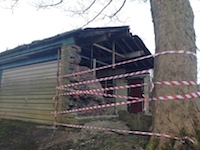March 2015
52 residents #13 John Hart
28/03/15 08:19
Week 13, a quarter of the way through the year, brings us to John Hart
John Hart bought the Springhill estate from Mrs Turner’s Trust on her death in 1923. He lived in Polefield Cottage and soon began to break up the estate, selling portions to other residents.
John Hart died in 1947, naming his wife Sarah Louisa (nee Murgatroyd) as sole Executrix, sole Trustee and main beneficiary. He willed that the properties be sold with the proceeds (apart from three personal bequests to various family members and friends) to be invested at Sarah Louisa’s absolute discretion with the income to be used for her own use absolutely.
She did not do this and continued to live in Polefield until her death in 1951. She also made a small number of personal bequests and willed that the remainder of her ‘property real and personal’ be treated as the residuary estate of her husband. Most of the Springhill houses had been sold off by that time so there may have been only Polefield and The Cottage left.
Her 3 executors were given £50 each for sorting this out.
As she made this will less that six months after her husband’s death, she obviously had no intention of carrying out his wishes.
John Hart willed that after the death of Sarah Louisa that there be a number of small bequests then the residue be divided equally between nineteen relatives and friends whom he helpfully listed together with (for the most part) addresses and relationships. One of the fixed bequests (of £50) was to the Peace Pledge Union, raising the possibility that he may have been a conscientious objector in WW1 - another avenue for study sometime.
After her death, Polefield was sold to the Trustees of Sion Baptist Church for use as a manse.
Sarah Louisa Hart left a bequest to her sister-in-law Sarah Evelyn Murgatroyd. Or rather, she willed that Sarah Murgatroyd’s oak table be returned to her….
Evelyn Murgatroyd lived next door to Polefield at The Cottage with her husband Harry, Sarah Hat’s brother. I remember Mrs Murgatroyd clearly (and Harry vaguely) from my childhood and teenage years. She always referred to her husband as ‘Mr Murgatroyd’ I also remember that she had a beautiful life-size Victorian porcelain baby doll in a wooden cot - an absolute delight which she was kind enough to allow me to play with. I do hope it is still in the family.
[As ever, the issues not directly related to the topic often catch the eye and the article in the Lancashire Evening Post 20 Feb 1934 in which a case at Preston Crown Court seemed to hang on the nationality of a cow is just begging for further attention]
John Hart bought the Springhill estate from Mrs Turner’s Trust on her death in 1923. He lived in Polefield Cottage and soon began to break up the estate, selling portions to other residents.
John Hart died in 1947, naming his wife Sarah Louisa (nee Murgatroyd) as sole Executrix, sole Trustee and main beneficiary. He willed that the properties be sold with the proceeds (apart from three personal bequests to various family members and friends) to be invested at Sarah Louisa’s absolute discretion with the income to be used for her own use absolutely.
She did not do this and continued to live in Polefield until her death in 1951. She also made a small number of personal bequests and willed that the remainder of her ‘property real and personal’ be treated as the residuary estate of her husband. Most of the Springhill houses had been sold off by that time so there may have been only Polefield and The Cottage left.
Her 3 executors were given £50 each for sorting this out.
As she made this will less that six months after her husband’s death, she obviously had no intention of carrying out his wishes.
John Hart willed that after the death of Sarah Louisa that there be a number of small bequests then the residue be divided equally between nineteen relatives and friends whom he helpfully listed together with (for the most part) addresses and relationships. One of the fixed bequests (of £50) was to the Peace Pledge Union, raising the possibility that he may have been a conscientious objector in WW1 - another avenue for study sometime.
After her death, Polefield was sold to the Trustees of Sion Baptist Church for use as a manse.
Sarah Louisa Hart left a bequest to her sister-in-law Sarah Evelyn Murgatroyd. Or rather, she willed that Sarah Murgatroyd’s oak table be returned to her….
Evelyn Murgatroyd lived next door to Polefield at The Cottage with her husband Harry, Sarah Hat’s brother. I remember Mrs Murgatroyd clearly (and Harry vaguely) from my childhood and teenage years. She always referred to her husband as ‘Mr Murgatroyd’ I also remember that she had a beautiful life-size Victorian porcelain baby doll in a wooden cot - an absolute delight which she was kind enough to allow me to play with. I do hope it is still in the family.
[As ever, the issues not directly related to the topic often catch the eye and the article in the Lancashire Evening Post 20 Feb 1934 in which a case at Preston Crown Court seemed to hang on the nationality of a cow is just begging for further attention]
nationality of a cow
21/03/15 19:42
Not my place but can’t resist….
Lancashire Evening Post 20 Feb 1934
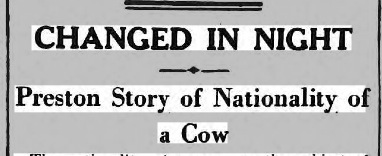
Lancashire Evening Post 20 Feb 1934

52 residents #12 Harry Hart
21/03/15 18:34
Private, 52219, 19 Btn King's Liverpool Regiment. d 23/06/1917 aged 23. Commemorated I B 5 Perth Cemetery China Wall, West-Vlaanderen, Belgium. He formerly served in the Manchester Regiment (3443), I haven’t been able to find when he transferred. He was awarded the British and Victory medals posthumously.
His death notice in the Manchester Evening News (16 July 1917) says 'of Higher Cloughfold'. The ‘Soldiers Died in the Great War’ register has his death as ‘France and Flanders’ which narrows it down a bit…
He was the son of the late James and Maria Hart and on the 1911 census is enumerated at 199 Bacup Road Cloughfold, single, 1 brother and 1 sister at home. At that time he was a cotton spinner but later became the assistant librarian at Rawtenstall library. He was the librarian at Burnley Mechanics Institute on enrolment.
Cotton Spinner - Librarian - Soldier. All before he was 23
My mother, another Springhill resident, was also assistant librarian at Rawtenstall Library 50 years later. Rawtenstall Library is a Carnegie Library opened in 1906 with an official opening in 1907 attended by Carnegie himself.
He is the third serviceman covered in this series and between them they served in 4 different regiments with no overlap. Of the 8 local casualties of WW1, three were in the East Lancs and two in the Loyal North Lancashire.
His death notice in the Manchester Evening News (16 July 1917) says 'of Higher Cloughfold'. The ‘Soldiers Died in the Great War’ register has his death as ‘France and Flanders’ which narrows it down a bit…
He was the son of the late James and Maria Hart and on the 1911 census is enumerated at 199 Bacup Road Cloughfold, single, 1 brother and 1 sister at home. At that time he was a cotton spinner but later became the assistant librarian at Rawtenstall library. He was the librarian at Burnley Mechanics Institute on enrolment.
Cotton Spinner - Librarian - Soldier. All before he was 23
My mother, another Springhill resident, was also assistant librarian at Rawtenstall Library 50 years later. Rawtenstall Library is a Carnegie Library opened in 1906 with an official opening in 1907 attended by Carnegie himself.
He is the third serviceman covered in this series and between them they served in 4 different regiments with no overlap. Of the 8 local casualties of WW1, three were in the East Lancs and two in the Loyal North Lancashire.
52 residents #11 Charlotte Anne Hargreaves
14/03/15 12:44
How far can the tentacles of a one-place study into a small hamlet stretch? How tenuous does a link have to be to count?
In 1834 John Ashworth bought the land on which Springhill now stands from the Rev William Thursby, Eleanor Mary his wife and Charlotte Ann Hargreaves. Eleanor Mary Thursby and Charlotte Anne Hargreaves were the daughters of John Hargreaves and Charlotte Anne Ormerod. Charlotte Anne Ormerod was the heiress of the Ormerod family of Ormerod nr Burnley. John Hargreaves’ ancestry and estate are described in the Genealogical and Heraldic History of the Commoners of Great Britain and Ireland 1825 pp 685-686 . They were armigerous, with their arms being allowed in 1623, so fairly early.
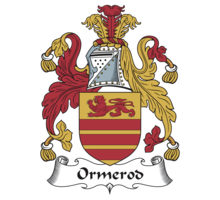
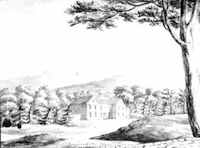
Ormerod House c 1811
The settlement prior to Charlotte Anne’s marriage in 1835 also describes the surrender into Trust of ‘Clough Fold farm’ but this is not otherwise described. This surrender also describes the surrender of ‘tenements in Habergham Eaves and the Colliery’. Whilst it helpfully doesn’t specify which colliery, Habergham Eaves (where they may have been a colliery) and Gambleside (where there definitely was a colliery) are very close to Ormerod. Now Gambleside was owned by Ashworth Hargreaves Co - the Ashworth being the one who bought the land from Charlotte Anne. John Ashworth’s wife was Betty Ormerod and there are hints in his obituary that he was linked with the Ormerod family from Whitewell Bottom, almost certainly an offshoot of the Burnley Ormerods. It is tempting to speculate that there was a familial link between John Ashworth and Charlotte Anne Hargreaves via her mother, this remains unproven (or, indeed, un-searched for!).
Charlotte Anne Hargreaves married James Yorke Scarlett in 1835. As he came from Middlesex, I wonder how they met - he was billeted at Burnley Barracks but that seems unlikely. There was no issue.
Scarlett rose to Lt-General and was commander of the charge of the heavy brigade at the battle of Balaclava. He was MP for Guildford (Cons) from 1837-1841 without any apparent connection with the town and stood unsuccessfully for Burnley in 1868. He is recorded in the Country Families of the United Kingdom1860, pg 886-887.
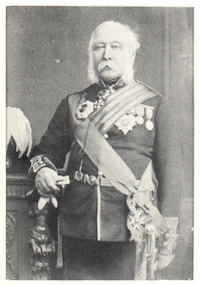
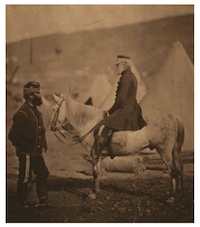
Charlotte Anne Scarlett nee Hargreaves died 9 Feb 1888 leaving (after two revisions) £627,738 15s 6d (Probate Calendar). A tidy sum, that 6d must have made all the difference.
From Springhill to Balaclava? Pushing it a bit…
In 1834 John Ashworth bought the land on which Springhill now stands from the Rev William Thursby, Eleanor Mary his wife and Charlotte Ann Hargreaves. Eleanor Mary Thursby and Charlotte Anne Hargreaves were the daughters of John Hargreaves and Charlotte Anne Ormerod. Charlotte Anne Ormerod was the heiress of the Ormerod family of Ormerod nr Burnley. John Hargreaves’ ancestry and estate are described in the Genealogical and Heraldic History of the Commoners of Great Britain and Ireland 1825 pp 685-686 . They were armigerous, with their arms being allowed in 1623, so fairly early.


Ormerod House c 1811
The settlement prior to Charlotte Anne’s marriage in 1835 also describes the surrender into Trust of ‘Clough Fold farm’ but this is not otherwise described. This surrender also describes the surrender of ‘tenements in Habergham Eaves and the Colliery’. Whilst it helpfully doesn’t specify which colliery, Habergham Eaves (where they may have been a colliery) and Gambleside (where there definitely was a colliery) are very close to Ormerod. Now Gambleside was owned by Ashworth Hargreaves Co - the Ashworth being the one who bought the land from Charlotte Anne. John Ashworth’s wife was Betty Ormerod and there are hints in his obituary that he was linked with the Ormerod family from Whitewell Bottom, almost certainly an offshoot of the Burnley Ormerods. It is tempting to speculate that there was a familial link between John Ashworth and Charlotte Anne Hargreaves via her mother, this remains unproven (or, indeed, un-searched for!).
Charlotte Anne Hargreaves married James Yorke Scarlett in 1835. As he came from Middlesex, I wonder how they met - he was billeted at Burnley Barracks but that seems unlikely. There was no issue.
Scarlett rose to Lt-General and was commander of the charge of the heavy brigade at the battle of Balaclava. He was MP for Guildford (Cons) from 1837-1841 without any apparent connection with the town and stood unsuccessfully for Burnley in 1868. He is recorded in the Country Families of the United Kingdom1860, pg 886-887.


Charlotte Anne Scarlett nee Hargreaves died 9 Feb 1888 leaving (after two revisions) £627,738 15s 6d (Probate Calendar). A tidy sum, that 6d must have made all the difference.
From Springhill to Balaclava? Pushing it a bit…
No. Just, No
11/03/15 17:20
The village shop in Higher Cloughfold has recently changed hands and the new owners have done some renovations. Now the old frontage was a bit scruffy and the window dressing left a lot to be desired but in general it was in keeping with the look of the village:
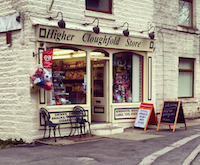
The new one is totally out of character…

…but I suppose we will get used to it. However they have managed to move the doorstep over the manhole cover which grants access to the cellar - hope they never have to use it.

The new one is totally out of character…

…but I suppose we will get used to it. However they have managed to move the doorstep over the manhole cover which grants access to the cellar - hope they never have to use it.
George Hargreaves part 2
07/03/15 22:15
It always pays to check all your sources thoroughly…
A couple of weeks ago in ’52 residents’ I wrote about George Hargreaves, chairman of the Sunday School committee at Sion, and my inability to track him down. I looked in the transcription of the gravestones in Sion, course I did, because I knew he was closely associated with the chapel and that the graveyard was open at the time of his death.
Couldn’t find him. That might be because he was buried elsewhere or that his stone was one of those said to have been lost during the renovations.
Looking in the database for something else today I came across:
‘Also of Mary Ann [Ormerod], their daughter, and wife of George Hargreaves died January 26th 1911 in the 68th year of her age’. This stone gives Mary Ann as daughter of James and Maria Ormerod and their death dates and ages.
So Mary Ann was 67 in 1911, b ~ 1844. It looks like Mary Ann Ormerod married George Hargreaves q4 1899 in Haslingden reg district , i.e. late in life. Cue a census trog.
John and Maria Ormerod in Cloughfold 1841 with their son Henry, who is also mentioned on the stone.
Both there in 1851 with Mary Ann, b 1844. John is woollen manufacturer employing 10 men 3 women 6 boys and 2 girls.
by 1861 he is a grocer - the decline of the small manufacturer with the growth of the mill?
1871 John is dead, Maria and Mary Ann still there.
1881 71 Newchurch Old Road. Mary Ann as general servant.
1891 71 Newchurch Road, living off own means
1901 still at 71 Newchurch Road, now as Mrs George Hargreaves. George is wast dealer (woollen), working on own account, aged 67 b Crawshawbooth ~ 1834.
So working back
1891 George Hargreaves at 26 Bacup Road with spouse Elizabeth (b ~ 1834) and daughter Jane Ellen b ~ 1860. Occupation Cotton Dealer.
1881 1 Green Bank Cottages with wife, daughter and 2 female lodgers. Occuptation ‘Waste dealer’
1871, 1 Green Bank cottages with wife, daughter and 1 female lodger, still there in 1881.
1861 Lord St, Newchurch with wife, daughters Betty b ~ 1857 and Jane Ellen and three lodgers (2F, 1M) all surnamed Hargreaves. Occupation Cotton Dresser. The lodgers are Sarah b ~ 1807 Deerply (I think) widow, Jane b ~ 1837 Goodshaw and Jacob b ~ 1845 Newchurch both single
1851. Well George isn’t married so is he with either of the lodger Hargreaves? Longholme Buildings gives us Head John Hargreaves b ~ 1802 Retired Loom Beamer, Spouse Sally b ~ 1802 and children Millison b ~ 1825, Betty b ~ 1827, Sarah b ~ 1829, John b ~ 1830, George b ~ 1833, Jane b ~ 1834, Hannah b ~ 1837, Joseph b ~ 1842 and Jacob b ~ 1845. The elder 7 born Higher Booths and the younger 2 in Newchurch. George then was a cotton weaver so it seems the lad did well for himself.
So both George and Mary Ann did well for themselves if George went from being a cotton weaver to self employed waste dealer and Mary Ann from general servant to living off her own means in 10 years…
Elizabeth was probably Elizabeth Ashworth whom he married q 2 1856. There were 7 Elizabeth Hargreaves died in the area between 1891 and 1899 so plenty more work to do.
So it looks like of my three likely contenders from the other week it’s the chap at 71 Newchurch Road, Cotton Waste Dealer. Don’t know where the idea that he ran his own building firm came from (see 52 residents #8).
Lessons of the week:
1. Check your resources thoroughly
2. Just because it’s in the paper doesn’t make it right. But we know that really.
A couple of weeks ago in ’52 residents’ I wrote about George Hargreaves, chairman of the Sunday School committee at Sion, and my inability to track him down. I looked in the transcription of the gravestones in Sion, course I did, because I knew he was closely associated with the chapel and that the graveyard was open at the time of his death.
Couldn’t find him. That might be because he was buried elsewhere or that his stone was one of those said to have been lost during the renovations.
Looking in the database for something else today I came across:
‘Also of Mary Ann [Ormerod], their daughter, and wife of George Hargreaves died January 26th 1911 in the 68th year of her age’. This stone gives Mary Ann as daughter of James and Maria Ormerod and their death dates and ages.
So Mary Ann was 67 in 1911, b ~ 1844. It looks like Mary Ann Ormerod married George Hargreaves q4 1899 in Haslingden reg district , i.e. late in life. Cue a census trog.
John and Maria Ormerod in Cloughfold 1841 with their son Henry, who is also mentioned on the stone.
Both there in 1851 with Mary Ann, b 1844. John is woollen manufacturer employing 10 men 3 women 6 boys and 2 girls.
by 1861 he is a grocer - the decline of the small manufacturer with the growth of the mill?
1871 John is dead, Maria and Mary Ann still there.
1881 71 Newchurch Old Road. Mary Ann as general servant.
1891 71 Newchurch Road, living off own means
1901 still at 71 Newchurch Road, now as Mrs George Hargreaves. George is wast dealer (woollen), working on own account, aged 67 b Crawshawbooth ~ 1834.
So working back
1891 George Hargreaves at 26 Bacup Road with spouse Elizabeth (b ~ 1834) and daughter Jane Ellen b ~ 1860. Occupation Cotton Dealer.
1881 1 Green Bank Cottages with wife, daughter and 2 female lodgers. Occuptation ‘Waste dealer’
1871, 1 Green Bank cottages with wife, daughter and 1 female lodger, still there in 1881.
1861 Lord St, Newchurch with wife, daughters Betty b ~ 1857 and Jane Ellen and three lodgers (2F, 1M) all surnamed Hargreaves. Occupation Cotton Dresser. The lodgers are Sarah b ~ 1807 Deerply (I think) widow, Jane b ~ 1837 Goodshaw and Jacob b ~ 1845 Newchurch both single
1851. Well George isn’t married so is he with either of the lodger Hargreaves? Longholme Buildings gives us Head John Hargreaves b ~ 1802 Retired Loom Beamer, Spouse Sally b ~ 1802 and children Millison b ~ 1825, Betty b ~ 1827, Sarah b ~ 1829, John b ~ 1830, George b ~ 1833, Jane b ~ 1834, Hannah b ~ 1837, Joseph b ~ 1842 and Jacob b ~ 1845. The elder 7 born Higher Booths and the younger 2 in Newchurch. George then was a cotton weaver so it seems the lad did well for himself.
So both George and Mary Ann did well for themselves if George went from being a cotton weaver to self employed waste dealer and Mary Ann from general servant to living off her own means in 10 years…
Elizabeth was probably Elizabeth Ashworth whom he married q 2 1856. There were 7 Elizabeth Hargreaves died in the area between 1891 and 1899 so plenty more work to do.
So it looks like of my three likely contenders from the other week it’s the chap at 71 Newchurch Road, Cotton Waste Dealer. Don’t know where the idea that he ran his own building firm came from (see 52 residents #8).
Lessons of the week:
1. Check your resources thoroughly
2. Just because it’s in the paper doesn’t make it right. But we know that really.
52 residents #10 Bathsheba Davenport
06/03/15 17:00
At last.
Bathsheba Davenport was born c 1796 in Manchester. She is listed in Slater’s Northern directory 1848 as Bathsheba Davenport as milliner in Newchurch.
On the 1851 census she is residing with her younger sister, Sarah, in Newchurch
Mannex 1854 states Rebecca Davenport, milliner, Newchurch
She was obviously a lady of some substance, owning stocks in the Liverpool Consolidated Gaslight Company, Shares in the Manchester and Liverpool District Banking Company and rental income from property on Coverdale St, Hamlet St, Emma St and Railway View in Ardwick, Manchester.
She died on 4 Sept 1893 and her will is fascinating.
She starts with the usual naming of executors with a legacy to each and a legacy to her nieces and nephews from the proceedings of her investments. Then follows a legacy to the children of her niece or nephews if any should happen to be blind, for as long as they remain blind. If none should be blind then the money is to go to blind people associated with the Chapels and Churches of Cloughfold, Mill End, Newchurch and Waterfoot and the congregational Chapel at Newchurch. There obviously were no blind family members as Bathsheba’s trust was mentioned in the Lancashire VCH entry for Newchurch in the above terms. The charity was registered with the charities commission in 1966 and removed in 2007 with income of £50. I don’t know if they ever paid out.
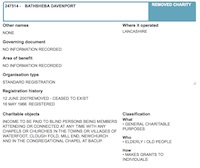
In addition there were a number of personal bequests in a codicil, many amended during drafting, including pictures of Mr and Mrs Gladstone with frames to one great nephew (gee, thanks) and her underclothing in equal shares to her two nieces (ditto - one take the bras and the other the knickers?) plus £5 to a couple of nonconformist ministers, one of whose names she did not know.
The blind bit got me thinking - reversible causes of blindness in the 19th century? There are a number of medical conditions of which blindness is a symptom which reverses at the condition improves but many of these were not treatable in C19. Many of today’s causes are preventable or treatment stops progression rather than truly reversible. So that leave us with cataracts, corneal scarring and retinal detachment to some extent.
Cataract surgery was first performed in 1746 and Freud and Koller’s later work on local anaesthesia was in part to facilitate this - Freud became a psychoanalyst and Koller a cocaine addict. corneal transplant was first attempted in 1838 although not successful before 1905. Retinal detachment surgery was rare before 1900 and rarely successful before the 1920s.
It appears therefore that Bathsheba’s stipulations came at a time when correction of blindness was, in some cases, beginning to become a reality. Did a spinster milliner in Newchurch have any idea of this?
Bathsheba Davenport was born c 1796 in Manchester. She is listed in Slater’s Northern directory 1848 as Bathsheba Davenport as milliner in Newchurch.
On the 1851 census she is residing with her younger sister, Sarah, in Newchurch
Mannex 1854 states Rebecca Davenport, milliner, Newchurch
She was obviously a lady of some substance, owning stocks in the Liverpool Consolidated Gaslight Company, Shares in the Manchester and Liverpool District Banking Company and rental income from property on Coverdale St, Hamlet St, Emma St and Railway View in Ardwick, Manchester.
She died on 4 Sept 1893 and her will is fascinating.
She starts with the usual naming of executors with a legacy to each and a legacy to her nieces and nephews from the proceedings of her investments. Then follows a legacy to the children of her niece or nephews if any should happen to be blind, for as long as they remain blind. If none should be blind then the money is to go to blind people associated with the Chapels and Churches of Cloughfold, Mill End, Newchurch and Waterfoot and the congregational Chapel at Newchurch. There obviously were no blind family members as Bathsheba’s trust was mentioned in the Lancashire VCH entry for Newchurch in the above terms. The charity was registered with the charities commission in 1966 and removed in 2007 with income of £50. I don’t know if they ever paid out.

In addition there were a number of personal bequests in a codicil, many amended during drafting, including pictures of Mr and Mrs Gladstone with frames to one great nephew (gee, thanks) and her underclothing in equal shares to her two nieces (ditto - one take the bras and the other the knickers?) plus £5 to a couple of nonconformist ministers, one of whose names she did not know.
The blind bit got me thinking - reversible causes of blindness in the 19th century? There are a number of medical conditions of which blindness is a symptom which reverses at the condition improves but many of these were not treatable in C19. Many of today’s causes are preventable or treatment stops progression rather than truly reversible. So that leave us with cataracts, corneal scarring and retinal detachment to some extent.
Cataract surgery was first performed in 1746 and Freud and Koller’s later work on local anaesthesia was in part to facilitate this - Freud became a psychoanalyst and Koller a cocaine addict. corneal transplant was first attempted in 1838 although not successful before 1905. Retinal detachment surgery was rare before 1900 and rarely successful before the 1920s.
It appears therefore that Bathsheba’s stipulations came at a time when correction of blindness was, in some cases, beginning to become a reality. Did a spinster milliner in Newchurch have any idea of this?
placenames
04/03/15 18:49
I am no expert on place names, though I find the subject fascinating.
Some are wonderfully vague. I suppose it was obvious to the parties involved in transactions recorded in the Court Rolls which were the ‘certain properties in Deadwenclough’ but I wish they had been more specific. The ‘Great Field behind the house’ does give us some clue but the ‘Cow Pasture’ could be anywhere…
Some need no interpretation however. Within 10 miles of Springhill we have
Wind Hill (Heywood)
Hailstorm Hill (Edenfield)
Hades Hill (Rochdale)
and, a little further away, Winter Hill.
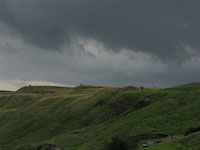
need I say more? Wet Moss (Musbury) or Wet Marl Wood (Burnley)and needs no explanation either.
However Dry Hill (Oswaldtwistle) sounds a bit more optimistic.
All this is before the guys from Rude Britain start…Titter ye not!
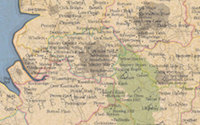
Some are wonderfully vague. I suppose it was obvious to the parties involved in transactions recorded in the Court Rolls which were the ‘certain properties in Deadwenclough’ but I wish they had been more specific. The ‘Great Field behind the house’ does give us some clue but the ‘Cow Pasture’ could be anywhere…
Some need no interpretation however. Within 10 miles of Springhill we have
Wind Hill (Heywood)
Hailstorm Hill (Edenfield)
Hades Hill (Rochdale)
and, a little further away, Winter Hill.

need I say more? Wet Moss (Musbury) or Wet Marl Wood (Burnley)and needs no explanation either.
However Dry Hill (Oswaldtwistle) sounds a bit more optimistic.
All this is before the guys from Rude Britain start…Titter ye not!





